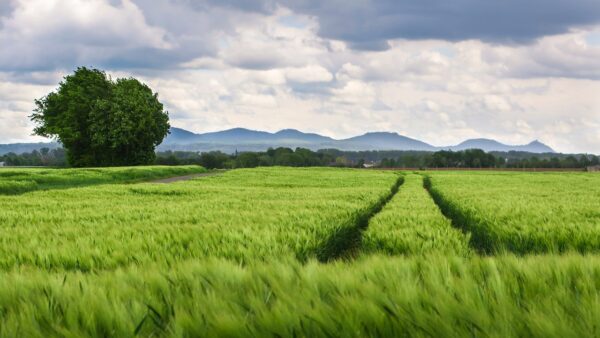Public and private entities come together to improve the production of cacao.
For some, it’s the language of love during Valentine’s Day and accompanies a bouquet of red roses. For others, it satisfies a craving for something rich or sweet. But the smooth, dark chocolate that is beautifully drizzled over fruit this time of the year or that delicately coats your favorite treat has a troubled beginning.
Far from the small chocolate shops that house cases full of flavored truffles and bonbons found in most U.S. cities, cacao farmers in West Africa work to etch out a living — many living on a subsistence-level income of $1 a day.
The cacao tree prefers rich, well-drained soils (often scarce in the tropics) and requires heat and humidity, only growing in a narrow band within about 18 degrees north and south of the equator.
By using modern agricultural practices, experts say farmers could easily triple yields of the cacao tree from the global average of about 460 kilograms of cacao bean per hectare (405 pounds per acre) to 1,500 kilograms per hectare (1322 per acre). As a result, their income could also triple.
Supply and Demand Factors
But with increasing yields comes a larger supply, which might be good for consumers; however, this ultimately reduces the price farmers receive for their goods. After years of stagnant growth, demand is finally going up.
Early last year, prices hit a four-year low due to an abundant supply and weakening demand. CNBC reported that benchmark cocoa futures on the Intercontinental Exchange in New York hit $2,052 per metric ton Feb. 3, 2017, the lowest level since March 2013. Experts said this was due in part to good weather in major production areas. Annual production is about 4 million tons.
West Africa, the hub of global cocoa production, is planted with about 6 million hectares (about 14.8 million acres) of cocoa, contributing 70 percent of total world production. The biggest producers are Côte d’lvoire, Ghana, Nigeria and Cameroon.
While demand in North America and Europe remains mostly stagnant, “demand for chocolate in Asia has been going up and continues to go up,” says Harold Poelma, Cargill’s president of cocoa and chocolate business. “Barring any major disruptions, we should have pretty decent growth this year.”
According to EuroMonitor International, Asia Pacific continues to be the strongest market for cacao ingredients, with a forecast compound annual growth rate of 4.5 percent from 2015-2020 compared with 1.7 percent for the world as a whole. This growth has made it the second largest region by volume, ahead of North America.
In the past decade, chocolate sales in China have doubled and a billion people are starting to enjoy it. But the U.S. remains the largest chocolate market. Americans eat roughly 10 pounds of it a year per person.
Production Perils
Despite demand, cacao remains a struggling crop. Essential to the livelihoods of 40-50 million people worldwide, cacao production is labor intensive, and farmers face many challenges. Crops are lost to disease, aging trees, outdated farming techniques and limited organizational and research support, according to the World Cocoa Foundation.
The three primary types of cacao trees are Criollo (rare), Forastero and Trinitario (a hybrid of the first two).
The threats facing cacao farmers varies by region.
In West Africa, Ghana’s cacao trees suffer insect damage, black pod rot, water mold and the swollen shoot virus. The fear is that these pests will attack healthy trees in neighboring Ivory Coast.
In Indonesia and Malaysia, the cacao pod borer tunnels into the center of the fruit and eats the seeds before tunneling back out. These pests, which cost cacao growers $600 million in crop losses a year, are difficult to control and extremely damaging to cacao-dependent economies, according to the Invasive Species Compendium.
Across the oceans, a fungal infection called witches’ broom in Brazil has reduced production by 80 percent. Another serious and damaging fungal disease called frosty pod rot is spreading through Latin America.
On a lesser threat level, cacao trees have little genetic variation, and the major varieties all come from the same species. Although the similarity among strains means they can easily be crossbred, it also means that the collected strains do not contain enough variation to provide much natural resilience to pests and disease. If one strain is genetically susceptible, chances are good they all will succumb. When farmers save their own seeds to plant new trees, this local inbreeding leaves the trees even more susceptible to pests and fungi.
Additionally, Hervé Bisseleua, World Cocoa Foundation director of productivity, says farmers have limited access to financing that would allow them to purchase supplies such as fertilizer and quality planting materials.
Digging Into the Genome

Source: Euromonitor
In 2010, Mars (maker of Snickers, M&Ms, Twix and much more) collaborated with the U.S. Department of Agriculture’s Agricultural Research Service and IBM to sequence Theobroma Matina 1-6, a type of cacao. The results were made public through an online Genome Database.
Simultaneously, another group comprised of Hershey, Pennsylvania State University and the French government worked to sequence Criollo, which cost an estimated $80 million.
Mark Guiltinan, a professor of plant molecular biology, was part of this consortium. He says the results were published in Nature Genetics in 2009, just a year after work commenced.
Today, he focuses on how genome sequencing accelerates the breeding of disease-resistant plants. Once Guiltinan’s team defines the most important genes for disease resistance, their next step is to identify plants that have higher levels of resistance. With the cacao sequence in hand, scientists believe molecular biology can be used to improve yields and create cacao varieties more resistant to disease.
Most of the genetic research centers on improved breeding practices, disease resistance, productivity, genetic identification of the beans and flavor.
“The genome map opens our understanding of the organism for the first time,” says Jimmy Lin, a Washington University in St. Louis computational genomics researcher. He helped to sequence the human genome at Johns Hopkins.
“Like the sequencing of the human genome, endless possibilities are now open,” Lin says. “However, further work is needed to decipher the genome to possibly modify it for pesticide resistance, flavor enhancement and longer survival.”
—This story originally appeared in February of 2018










